Environmental Initiatives
Our Commitment to a Greener Future
IIFL HFL is firmly committed to environmental sustainability. We have implemented a range of initiatives to minimise our overall environmental impact. Through our green building initiative, we promote the construction and financing of environmentally friendly housing projects. We diligently manage our energy consumption and emissions by implementing energy efficient practices throughout our operations. Responsible water management is also a priority as we treat and reuse water within our facilities and minimise water wastage. Additionally, our waste management practices centre on reducing waste generation, promoting recycling and reusing and ensuring the responsible disposal of any remaining wastes. Through these comprehensive environmental initiatives, we aim to positively impact the environment while providing sustainable housing finance solutions to our customers.
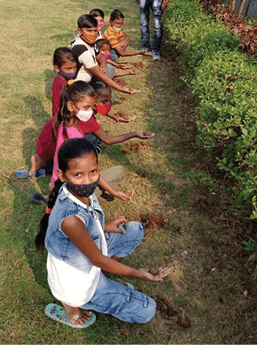
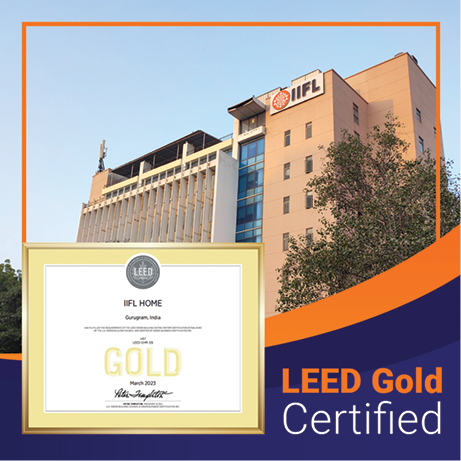
Asian Development Bank’s Technical Assistance Programme
IIFL Home Finance and the Asian Development Bank (ADB) collaborated for a Technical Assistance (TA) programme titled ‘Enabling the ecosystem to improve access to green affordable housing for women’. This programme represents a remarkable fusion of promotion and propagation, capacity building, and research and innovation, encompassing the realms of ‘green building,’ ‘affordable housing,’ and ‘women’s access to housing’ in India.
Promotion and Propagation

Kutumb
IIFL HFL, through it’s flagship green affordable housing knowledge sharing platform ‘Kutumb’, successfully brought together a diverse range of housing industry stakeholders. This includes developers, policymakers, architects, academicians, green rating agencies, and financial institutions, all united in our shared vision. By fostering this collaborative ecosystem, we are driving transformative change and propelling the growth of green affordable housing throughout the country.
2021
December
New Delhi
Climate resilient green and affordable housing in India
2022
April
Gujarat
Green Gujarat - Making housing green and affordable
May
AP & Telangana
Urgent need for green affordable housing
August
New Delhi
Pathway to climate adaptive design
September
Kolkata
Future-ready with green and affordable housing
October
Karnataka
Rebuilding green and affordable Karnataka
November
Pune
Expansion of green affordable housing
December
Bangladesh
Developing green affordable housing in Bangladesh
New Delhi
Green affordable housing eco-system In India
9
Kutumb platforms
1,500+
Participants
900+
Developers
36+
Expert sessions
For detailed reports, scan below:

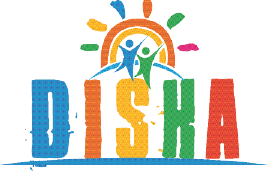
Disha
Disha, community engagement activities, are sustainable living workshops and sapling planting activations. These workshops were implemented at select EWS/LIG housing societies across the country with a primary objective to inspire children and women residing in these households to embrace sustainable lifestyles.
2022
Karnataka
Pragna Ashray
Kolkata
Bhawani Towers
September
2022
Maharashtra
Poonam Park View
Maharashtra
Belantara Today Royal
October
2022
Maharashtra
Sara City
Maharashtra
Mount Vista
November
2022
Haryana
Global Signature Synera
Haryana
Andour Heights
August
2022
Andhra Pradesh
Indrani Nilayam
Andhra Pradesh
K G V Towers
Telangana
Janapriya Heavens Apartment
May
2022
Telangana
Rajiv Swagruha
Sahbhavana Township
April
2022
Madhya Pradesh
Omaxe City 1 - Ashiyana
Uttar Pradesh
Migsun Roof
December
2022
Gujarat
Laxmi Niwas
Gujarat
Om Shanti Gold -1
Gujarat
Aavaas Nebula
January
2022
Gujarat
Mahek Residency
Gujarat
Ayodhya Township
Gujarat
Mahavir Bunglow -2
February
20
EWS/LIG societies
1,100+
People engaged
1,700+
Saplings planted
For detailed reports, scan below:

Study on ‘State of Sustainable Housing in India’
A study on ‘State of Sustainable Housing in India’ was published in November 2022, assessing the awareness of climate-resilient green housing among home buyers. The study helped us understand:
- Satisfaction & challenges with current accommodation
- Awareness & implementation of sustainable living
- Openness to adopt sustainable homes/initiatives
Capacity Building
As part of ABD’s TA, we collaborated with CEPT University’s Center for Urban Planning and Policy (CUPP) for the creation of various subject modules, such as

Design for Sustainability and Green Building

Policy (Convergence and Reforms)

Project Formulation & Appraisal

Green Building Site Implementation & Post Occupancy Evaluation
7
Training Programs in 6 cities
250+
Participants
27%
Training Women participation (nearly one-third)
90+
Unique organizations
Stakeholders targeted from organisations:
Government, Developers, HFC/Banks, International Property Consultants (IPC), Think Tanks, Academia, Architects and other construction professionals.
DIY Toolkit For Self Construction
As a part of capacity building, a do-it-yourself toolkit has been produced catering to the four different climatic zones of the country namely: Warm and Humid, Hot and Dry, Composite and Temperate.
The toolkit suggest the green and sustainable designs of three types of housing, based on typical home sizes in affordable self-built housing space, specific to each climatic zone.
The kit provides information on passive design, material selection, electrical and plumbing fixtures/equipment, waste management, and costing.
The kit is essentially made targeting stakeholders such as aspiring homeowners, architects, engineers, and technical representatives from Housing Finance Companies (HFCs), civil work contractors, masons, and other construction professionals involved in the process.
Research and Innovation
With CEPT University’s Center for Advanced Research in Building Science & Energy (CARBSE), we conducted research and innovation endeavors centered on several crucial areas as follows.
Green Building Rating Systems: Assessment and Gap Identification
Financing Green and Affordable Housing
Financial Mechanisms to Support the Design and Operation of Climate Responsive and Climate Resilient Affordable Housing
Integrating Green Lending in Affordable Housing Finance: Policy Recommendations and Interventions for Financial Institution
Policy Recommendations and Implementation Model enhancing the current state of Green Affordable Housing in India
Compendium of strategies making buildings Climate Responsive and Resilient
Unified Green Building Rating Program
Mainstreaming Gender Sensitivity in Green Affordable Housing: Guidelines
Green Affordable Housing in India: Best Practices
Innovative Construction Technologies for Green Affordable Housing
Green Value Partners
Conception to certification
Green Value Partners (GVP)
IIFL HFL’s ‘Green Value Partners (GVP)’ are a crucial intermediary between our developers, green certification agencies and green building consultants, supporting the developers with green building methodologies and certification.
| Description | FY 2022-23 | FY 2021-22# | Cumulative till March 31, 2023 |
|---|---|---|---|
| Memorandum of Understanding (MoU) | |||
| Total signed | 13 | 18 | 59 |
| Closed in FY 2021-22 | 0 | 5 | 5 |
| Closed in FY 2022-23 | 2 | 8 | 10 |
| Active signed (as on March 31, 2023) | 11 | 5 | 44 |
| *Atulya Raghukul was dropped in FY 2021-22 & reinitiated in FY 2022-23 | |||
| Projects Under Managemnet (PUM) Projects | |||
| Total PUM* | 12 | 9 | 49 |
| Closed in FY22-23 | 0 | 4 | 4 |
| Active PUM (as on March 31, 2023) | 12 | 5 | 45 |
| Units Under Management | 7,391 | 7,340 | 36,361 |
| Unit deductions due to closed PUM in FY22-23 | 0 | 2,053 | 2,053 |
| Active units under management | 7,391 | 5,287 | 34,308 |
| *Sitara & Lakefront was dropped in FY 2021-22 & reinitiated in FY 2022-23 | |||
| Pre-certified & Certified Projects | |||
| Total Pre-Certified Projects | 7 | 10 | 30 |
| 1. IGBC Green Affordable Housing (Gold) | 6 | 7 | 18 |
| 2. IGBC Green Affordable Housing (Platinum) | 1 | 2 | 4 |
| 3. IGBC Green Homes (Gold) | 0 | 0 | 5 |
| 4. IGBC Green Homes (Platinum) | 0 | 1 | 2 |
| 5. GRIHA rating (V.2015 - 4 stars) | 0 | 0 | 1 |
| Certified Projects** | 0 | 0 | 1 |
| 1. IGBC Green Homes (GOLD) | 0 | 0 | 1 |
| Units Under Monitoring | 4,869 | 8,233## | 22,995 |
| Climate Impacts from GVP | |||
| Energy savings (MWH/annum) | 3,323 | 5,619 | 15,694 |
| GHG emissions offset (TCO2e/annum) | 3,057 | 5,169 | 14,438 |
| Water savings (ML/annum) | 192 | 325 | 907 |
| Closed Projects | |||
| Total Closed Projects*** | 31 | 20 | 51 |
| Restarted Projects**** | 2 | 0 | 2 |
Nomenclature
MoU signed is the sum of prospective projects and projects under management (PUM) for which MoU is signed with the developer. The following projects are excluded:
Kakade VTP
Yashozone Horizonte
Bricktown
* In FY 2020-21, a PUM was defined as any project where an MoU got signed. In FY 2021-22 & FY 2022-23, PUM was redefined as any project that fulfilled all the following conditions:
MoU is signed with developer
GBC is hired
Project gets registered for certification with IGBC/GRIHA/EDGE
Units Under Management are the total number of dwelling units for all the projects that are under management. The number of PUM units in one plotted project has not been included here
Pre-Certified Projects are the total number of projects that got IGBC/GRIHA/EDGE Pre-certification. Pre-certified projects are under monitoring and included in ‘PUM’
**Certified Projects are the total number of projects that got IGBC or GRIHA Final certification. Certified projects are considered as ‘completed’ and not included in ‘PUM’
***Dropped Projects are the prospective projects which do not become PUMs and PUM projects that could not move forward pre-certification/certification. Dropped project will be referred as ‘closed projects’ from FY 2022-23 onwards.
Re-initiated projects are those which got dropped in earlier FY but were restarted in FY 2022-23.
#Revised additions based on projects that got closed in FY 2021-22 & FY 2022-23
## The reporting of climate impacts is based on units under monitoring. This number was not declared in FY 2021-22. Units under monitoring are the number of units for all pre-certified projects. However, going forward it will be disclosed. In FY 2021-22, in line with the common principles for climate mitigation finance tracking, the units under monitoring were under reported by 40 Nos. This has now been rectified and disclosed.
Investment Case
Kingston Greens, Pune, Maharashtra
Kingston Greens serves as a remarkable case study in the realm of affordable housing, showcasing the integration of affordability and sustainability throughout its lifecycle. Situated in Pune, this project is a testament to the benefits of incorporating green design strategies. Kingston Greens has obtained the prestigious IGBC PLATINUM pre-certification, affirming its compliance with the Green Affordable Housing rating system. The project embraced a firm commitment to sustainable practices from inception to realisation, thereby minimising adverse environmental impacts. This noteworthy undertaking was constructed through a collaborative funding effort involving the Asian Development Bank (ADB) and the Canadian Climate Fund for the Private Sector in Asia (CFPS). Kingston Greens is a shining example of how affordable housing can successfully align with sustainable principles, positively impacting the community and the environment.
IGBC Platinum
Pre-certified project
Climate impact
202.70 MWh/annum
Energy savings
186.49 tCO2e/annum
GHG emissions offset
11.71 ML/annum
Water savings
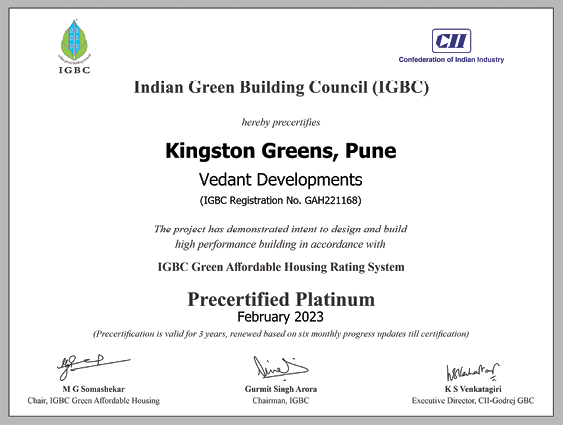
Govardhan Heights, Jaipur, Rajasthan
Govardhan Heights represents another exemplary case study in the realm of affordable housing, where sustainable design and construction practices have been successfully embraced. Through valuable consultation with IIFL Home Finance’s Green Value Partner (GVP) Team, the project was able to incorporate and execute sustainable strategies. As a testament to its commitment to sustainability, Govardhan Heights has achieved the notable certification of ‘GOLD’ under the Green Affordable Housing rating system administered by the Indian Green Building Council (IGBC). This recognition highlights the project’s adherence to rigorous standards of environmental responsibility within the affordable housing sector. Govardhan Heights serves as an inspiring model for the integration of sustainability into affordable housing projects, offering a promising vision for a greener and more inclusive future.
IGBC Gold
Pre-certified project
Climate impact
343.30MWh/annum
Energy savings
315.83tCO2e/annum
GHG emissions offset
19.83 ML/annum
Water savings
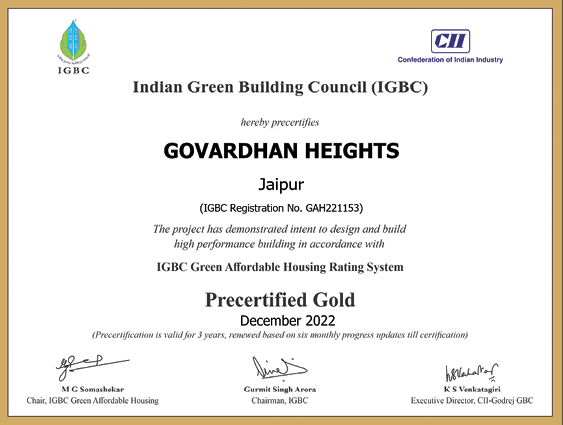

Energy and Emissions
Our Company is committed to actively reducing energy consumption across our various office locations. To achieve this, we have implemented an energy management system at several sites, including our corporate headquarters. This system efficiently controls and oversees heating, ventilation, air conditioning, and lighting, ensuring that energy is used judiciously and only when necessary.
Sensors throughout our offices
to conserve electricity
Ban on single-use plastics
at all our offices and branches
Energy and Emissions from Direct Operations
| Parameters | Unit | 2022-23 | 2021-22 | 2020-21 |
|---|---|---|---|---|
| Energy consumption from use of diesel | GJ | 921.42 | 792.17 | 413.16 |
| Scope 1 Emissions | tCO2e | 68.69 | 59.04 | 30.79 |
Energy and Emissions from Indirect Operations
| Parameters | Unit | 2022-23 | 2021-22 | 2020-21 |
|---|---|---|---|---|
| Electricity consumption | MWh | 848.41 | 900.27 | 765.58 |
| Scope 2 Emissions | tCO2e | 589.06 | 711.22 | 620.16 |
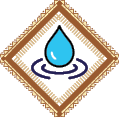
Water Treatment
We have recognised the significant impact of water consumption at our branches, and have taken several measures to promote responsible water usage. Firstly, we have installed a sewage treatment plant to efficiently treat wastewater at our Gurugram Head Office. The treated water is then utilised for various purposes such as gardening and cleaning. Additionally, we have implemented servicing for water softeners to ensure the availability of treated water for applications such as washrooms, cleaning, and cooling towers. We have installed aerators to minimise water consumption by optimising water flow. To safeguard the drainage system, chambers have been installed to prevent soil from entering and causing blockages.
Water Consumption
1,920 kL
Municipal water
869 kL
Boring water
445 kL
Bottled water
3,234 kL
Total water
0.71 kL/Employee
Water intensity
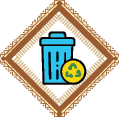
Waste Management
With a strong emphasis on the principle of reduce, reuse, and recycle. We are dedicated to minimising waste generation, and actively seeking opportunities to recycle products for future use. We have made significant strides in transitioning our business operations to online platforms, allowing us to provide documents and statements digitally. This shift not only enhances convenience but also reduces paper waste. Additionally, we prioritise the proper disposal and recycling of electronic waste (e-waste) by partnering with reputable e-waste vendors.
201.4 Kg
Hazardous waste (E-waste) disposed
